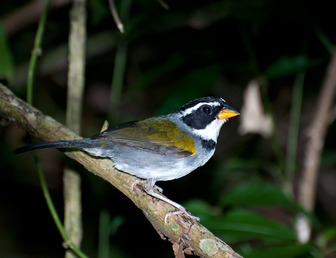Half-collared Sparrow
Its natural habitats are subtropical or tropical moist lowland forests and heavily degraded former forest.

Original source: Dario Sanches from São Paulo, Brazil
Author: Dario Sanches from São Paulo, Brazil
The Half-collared Sparrow is classified as Least Concern. Does not qualify for a more at risk category. Widespread and abundant taxa are included in this category.
* Half-collared Sparrow, Arremon semitorquatus * Golden-winged Sparrow, Arremon schlegeli * Black-capped Sparrow, Arremon abeillei * Saffron-billed Sparrow, Arremon flavirostris Genus Arremonops * Olive Sparrow, Arremonops rufivirgatus * Tocuyo Sparrow, Arremonops tocuyensis * Green-backed Sparrow, Arremonops chloronotus * Black-striped Sparrow, Arremonops conirostris Genus Melozone * Rusty-crowned Ground-Sparrow, Melozone More
The Half-collared Sparrow (Arremon semitorquatus) is a species of bird in the Emberizidae family. It is endemic to Brazil. Its natural habitats are subtropical or tropical moist lowland forests and heavily degraded former forest. References - * BirdLife International 2004. Arremon semitorquatus. 2006 IUCN Red List of Threatened Species. Downloaded on 25 July 2007. More
Half-collared Sparrow (Arremon semitorquatus) = * Least Concern * List * Thumbs * All * Videos * Photos * Sounds Videos 1 video * Video preview image A bird moving and singing in dense vegetation Fazenda More
Half-collared Sparrow is very similar to ] but never shows the yellow shoulder of that species. Half-collared Sparrow is found south of and adjacent to the nominate form of Pectoral Sparrow which differ in flank color, mandible color, and in having a complete breast band (but Half-collared Sparrow is, except for lacking the yellow sholder, more similar in plumage to the northern forms of Pectoral Sparrow). More
Half-collared Sparrow was considered a subspecies of Pectoral Sparrow by some authorities. Habitat - Lowlands; where adjacent to Half-collared Sparrow, Pectoral Sparrow tends to be found at lower elevation. Behaviour - Vocalizations: tends to start with some thin tseet notes followed by three drawn out notes of a screechy quality. References - 1. More
Half-collared Sparrow Arremon semitorquatus 2009 IUCN Red List Category (as evaluated by BirdLife International - the official Red List Authority for birds for IUCN): Least Concern Justification This species has a very large range, and hence does not approach the thresholds for Vulnerable under the range size criterion (Extent of Occurrence 30% decline over ten years or three generations). More
(Arremon semitorquatus) Half-collared Sparrow Add this Bird STATISTICS: Total Species on Checklist: 314 Species Reported: 67 RECENT SIGHTINGS IN THIS REGION: Song Sparrow Map | 05/09/2010 Swamp Sparrow Map | 05/06/2010 Eastern Towhee Map | 05/04/2010 Lincoln's Sparrow Map | 05/01/2010 Song Sparrow Map | 05/01/2010 More
Half-collared Sparrow (Arremon semitorquatus) Half-collared Sparrow (Arremon semitorquatus) Black-cheeked Gnateater (Conopophaga melanops) Black-cheeked Gnateater (Conopophaga melanops) Ochre-faced Tody Flycatcher (Todirostrom plumbeiceps) Ochre-faced Tody Flycatcher (Todirostrom plumbeiceps) Rufous-bellied Thrush (Turdus rufiventris) Rufous-bellied Thrush (Turdus rufiventris) White-throated Hummingbird (Leuchochloris albicollis) - This superb hummer is endemic to the Atlantic Rainforest White-throated Hummingbird (Leuchochloris albicollis) Sombre Hummingbird (Campylopterus cirrhochloris) Sombre Hummingbird (Campylopterus cirrhochloris) Saw-billed More
Half-collared Sparrow (Arremon semitorquatus) A single seen on the High Altitude (lower) excursion. Uniform Finch (Haplospiza unicolor) 6 seen on the High Altitude (lower) trail and 4 on the seen on the High Altitude (upper) trail. Bay-chested Warbling-finch (Poospiza thoracica) A single seen on the High Altitude (lower) trail and 3 on the seen on the High Altitude (upper) trail Saffron Finch (Sicalis flaveola) Several seen e.g. More
Half-collared Sparrow - Arremon semitorquatus Half-collared Sparrow has recently been split from the widespread Pectoral Sparrow Arremon taciturnus, forming a new Atlantic Forest and Brazilian endemic. They are usually found at higher altitudes. Here at Vale das Taquaras the Long Trail is a very good spot for them. They are very distinctive birds but are usually very retiring, hiding in dense cover, and so their call is the best way of finding them. More
Half-collared Sparrow (Arremon semitorquatus) by Ricardo Gagliardi. More
Family : Emberizidae
Genus : Arremon
Species : semitorquatus
Authority : Swainson, 1837

